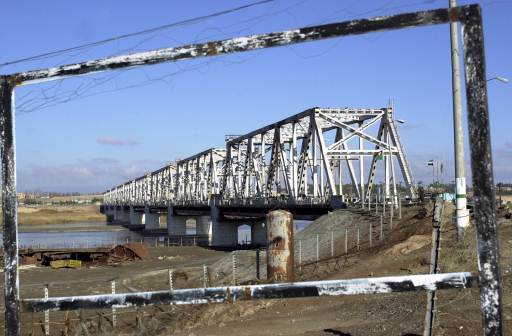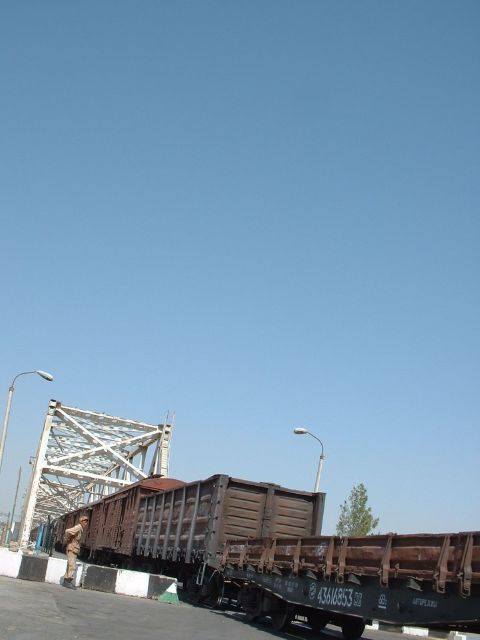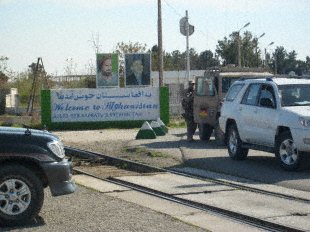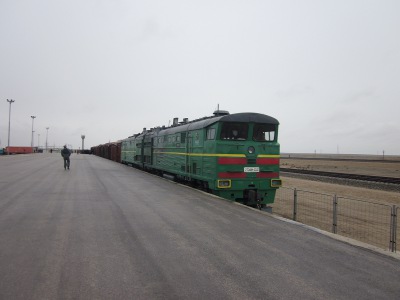Previous page: Iran to Herat line
The 75 km line from the Uzbek border to a terminal near Mazar-i-Sharif is not the first railway in Afghanistan, but it is the first substantial common carrier main line railway operating in the country.
First commercial train to Naibabad, 3 February 2012 (Photo: David Brice).
Background
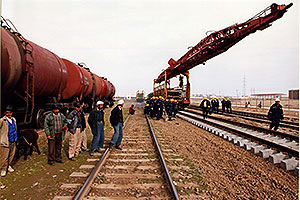
The River Amu Darya forms the border between Uzbekistan and northern Afghanistan. The only fixed crossing between the countries is the Soviet-built Friendship Bridge, which carries a road and single-track railway.
The bridge leads directly to the Hairatan freight terminal on the Afghan bank of the river, but the border is a bottleneck. Freight had to be transshipped from rail to road in Hairatan, and the transport infrastructure could not cope with expanding trade and the delivery of humanitarian aid.
The Friendship Bridge is now busy, with freight trains of up to 30 wagons bringing petroleum products, building materials, machinery and agricultural products into Afghanistan. Traffic in 2009 amounted to 4000 tons/ month, and the total flow of goods from Central Asia to Afghanistan is predicted by ADB to increase from 25 000 tons to 40 000 tons per month ‘over the next few years’, with goods including oil and fuel, wheat and flour, fertilizer, construction materials, agricultural and off-highway equipment and consumer goods.1 Little merchandise is exported from Afghanistan, perhaps 10% of the imports, and most wagons leave empty.2.
The road between Hairatan and Mazar-i-Sharif has been improved in recent years, but it cannot meet the requirements of national and regional traffic and so a railway was built to replace current lorry transport.3 As well as increasing freight capacity, replacing road transport with rail is expected to reduce accidents and pollution, and cut road maintenance costs.
The railway is expected to have a significant economic impact, as almost half of Afghanistan’s imports pass through Hairatan.4
ADB estimates that the opening of the railway will quadruple capacity at the border. 5 The project includes an upgrade of the rail freight facilities at Hairatan, including a transshipment terminal and institutional support for the development of a wider plan for the rail sector.
According to ADB the new railway will carry ‘commercial and non-military cargo.’ However transport routes through Uzbekistan are currently used to carry supplies to international military forces in Afghanistan, and it is possible that agreements could be used for the line to carry military traffic. Routes to Afghanistan through central Asia avoid the security issues of passing through Pakistan to southern Afghanistan, but do suffer from the need to cross the multiple borders between Europe and Afghanistan, with the attendant delays, bureaucracy and political disruptions.
History
Various proposals have been put forward over the years for a railway from Uzbekistan into Afghanistan. The Soviet Union opened the Friendship Bridge in 1982 during its intervention in Afghanistan and signed an agreement with the Afghan government for a 250 km railway running to Kholm, Kunduz, Khanabad. Ab Kul, Bahlan the Surkhab river valley to terminate at Pul-i-Khumri, 150 km north of Kabul.6 However the line was not built.
In 2008 German magazine Spiegel reported7 that the German military was considering building a 67 km railway from Hairatan to Mazar-i-Sharif, which would provide supplies to NATO troops and stimulate the local economy. The project could be based on the Soviet plans, but the cost had not been calculated. Nothing seems to have come of this plan, if indeed it was ever seriously considered.
ADB provides the money
The project for a railway from the Uzbek border to Mazar-i-Sharif finally got underway after the Asian Development Bank decided to meet most of the cost through a grant.
Afghan Minister of Finance Dr Anwar-Ul-Haq Ahady and Uzbek Minister for Foreign Economic Relations, Investment & Trade Elyor Ganiev signed a memorandum of understanding between their respective governments and the Asian Development Bank at the seventh annual Central Asia Regional Economic Cooperation (CAREC) Ministers’ Conference in Baku in November 2008.8 This set out plans to expand trade and economic opportunities by developing railway transport between Uzbekistan and Afghanistan, including transit freight traffic.
In the memorandum the Afghan government highlighted the importance of developing a line between Hairatan,9 Mazar-i-Sharif and Herat, and requested technical and financial assistance from ADB in order to prepare a pre-feasibility study. Uzbekistan agreed to co-operated with the study, which would be supervised by a Project Working Group comprising representatives from both countries.
Uzbekistan and Afghanistan had recently signed the Uzbekistan-Afghanistan Boundary Railway Agreement, the Freight Transportation Rules for the Uzbekistan-Afghanistan Railway, and Rules for Passenger Transport and Freight Accounts for the Uzbekistan-Afghanistan Railway.
In 2009 ADB provided a technical assistance grant of US$1.2m to fund a feasibility study for two for railway lines, running from Hairatan to Herat, and from Shirkhan Bendar10 on the border with Tajikistan through Kunduz and Mazar-i-Sharif to Herat. The Afghan government provided an ‘in-kind contribution equivalent to $60,000’, and its Ministry of Public Works was the executing agency.
According to ADB only half the roads between Afghan provinces are serviceable throughout the year, and the network is ‘inadequate, inefficient and, in some places, unsafe’.11 Railways would provide ‘a more reliable and cost-effective option for moving people and goods, and can help Afghanistan unlock its significant mineral, industrial and agricultural wealth.’
ADB awarded Concept Clearance for the Hairatan – Mazar-i-Sharif project on 9 July 2009, and fact-finding was carried out on 9-18 August.
On 30 September 2009 ADB announced it would provide the Afghan government’s with a US$165m grant to cover most of the US$170m cost,12 leaving the Afghan government to fund the final US$5m for land acquisition, resettlement, and taxes. The agreement came into effect on 3 November 2009.
The railway
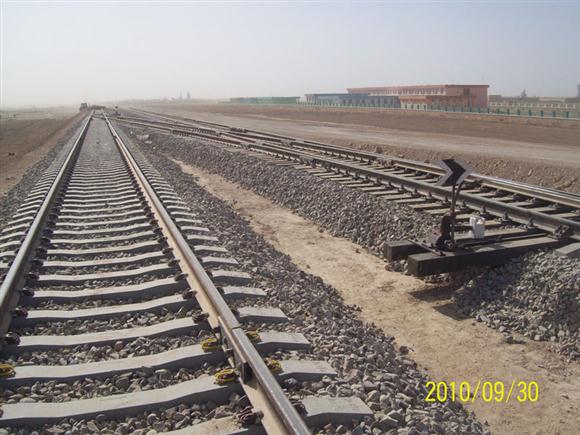
A ceremony on 22 January 2010 marked the formal start of work to build the railway.
| Hairatan to Mazar-i-Sharif railway | |
|---|---|
| Length | 73.47 km |
| Start | Friendship Bridge, Hairaton (east of Termez, Uzbekistan) |
| End | Gur-e-Mar (18 km east of Mazar-i-Sharif) |
| Gauge | 1520 mm |
| Cost | US$170m (Asian Development Bank US$165m, Afghan government US$5m |
| Completion | construction November 2010 contractual date June 2011 |
The 73.47 km13 alignment starts at the Friendship Bridge then runs parallel to the Hairatan – Naiababad road and a 330 kV electricity transmission line. It then crosses the A76 road west of Naiababad, turning west to terminate to the south of the village of Gur-e-Mar, 18 km east of Mazar-i-Sharif and not far from the airport.
The line is effectively an extension of the Uzbek rail network, with construction and future operations necessarily following Uzbek technical standards, and thus the standards found right across the countries of the former USSR.
The single-track 1520 mm gauge unelectrified line was designed for speeds of 80 km/h. Passing loops were to be provided every 20 km, and would be 1.7 km in long to accommodate 100 wagon trains. It was expected that one or two trains a day will use the line, and clearances are suitable for double-stack containers.
The landscape is gently rolling or flat plain at an elevation of 350 to 550 m. It is featureless and barren, partly desert with no natural vegetation and partly semi-desert with the sparse ground cover limited to drought-resistant grasses which die back in summer. Most of the route is many kilometres from inhabited areas, and other than the Amu Darya there are no surface water features within 10 km.
This meant there would be minimum loss of useful land for the project. No archaeological sites, cemeteries or other ‘socio-cultural facilities’ are affected by construction.14
Land acquisition and resettlement accounted for just US$0.5m of the project budget, as all of the route is through government land except for a total of 880 m² art Qalinbafan’s Camp, between Naibabad and Gur-e-Mar, where two plots of land and 15 people are affected.15
There was no opposition to the project during four public consultation events which took place on 19, 21 and 31 July and 3 August 2009. Government officials and villagers welcomed the railway, with the locals believing it would provide an opportunity to increase the trade in farm produce by enabling them to access markets further afield than at present.
Contracts placed
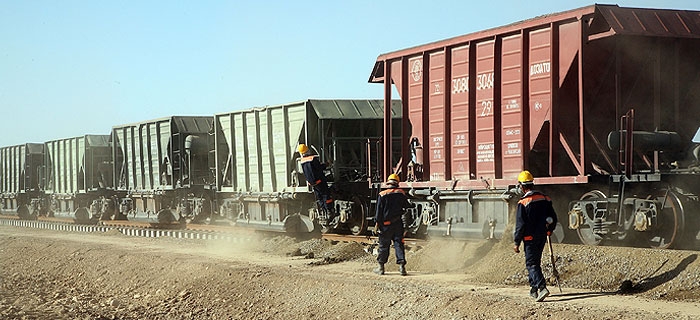
The project was supervised by the Afghan Ministry of Public Works, which is responsible for overall execution and co-ordination.
Uzbekistan’s state railway company Uzbekistan Temir Yullari possessed previously-drawn up proprietary plans for the construction of the line, and has gained extensive railway construction experience in similar physical environments within Uzbekistan. The problems companies face when working in Afghanistan and ADB’ s previous experience of cost overruns and delays with Afghan transport projects lead the bank to believe there would be few if any other bidders if competitive tenders were called for construction. ‘There are no comparable companies in the region capable of designing, building, operating and maintaining a line based on the Uzbekistan system’, the bank concluded.16 As a result the bank relaxed its usual procurement rules to allow the Afghan government to award UTY a US$129m design and construction contract without tendering on 27 November 2009.
No new rolling stock was required, as Uzbek vehicles were used. UTY operates the completed line under a performance-based and time-limited operation and maintenance contract which was to be agreed by 31 October 2010. The grant agreement required the Afghan government to produce a railway subsector restructuring plan by the time the project is completed, ‘contemplating gradual and phased disassociation from the government to attain the railway system’s financial and operational independence’.17
UTY’s existing plans allowed it to make a rapid start with construction once the political go-ahead was received and the financing was in place. Design review and supervision contracts were awarded on 30 November 200918 , with Boshtransloyiha appointed as designer, and a consortium of Australian firm SMEC International Pty Ltd19 and Uzbek firm Islohotkonsaltservis20 have a US$3 896 792 contract for design review and construction supervision.
President of Uzbekistan Islam Karimov signed a resolution “On measures on realization of project “Designing, construction, establishment and commission to exploitation of railroad line between Hairatan and Mazar-i-Sharif” on 20 November 2009.21 This set out the tax and customs rules governing the project, which required almost all materials to be supplied from Uzbekistan because Afghanistan has no domestic rail supply industry.
The Uzbekinvest export-import company provided insurance for the workers while they are in Afghanistan. Workers are reported to be relatively well paid at around US$500 a month and receive tax concessions, though some returning to Uzbekistan criticised conditions in the local media.22
Although ADB warned in September 2009 that that “security remains an ongoing concern in Afghanistan”, the area where the railway was being built is “relatively safe” and the Afghan government would provide “all necessary security support”.23
Major civil engineering works started in January 2010, with a contractual completion date of June 2011.
Opening
An empty test train ran on 21 December 2011.24 This was followed by the first train carrying commercial freight on 3 February 2012. UTY locomotive 2??10?-2337 hauled nine wagons carrying flour from Kazakhstan and three wagons of Siberian timber.
Another view of the first commercial train to Naibabad, 3 February 2012 (Photo: David Brice).
Studies are being undertaken for the construction of a further lines from Mazar-i-Sharif west to Herat (with connections to Iran) and east to Shirkhan Bandar (for Tajikistan). These lines would create a rail corridor through the north of Afghanistan, enabling Tajik and Uzbek freight to reach the Persian Gulf ports by rail without passing through the other country or Turkmenistan.
Next page: Sogdiana Trans
References
- Proposed Asian Development Fund Grant Islamic Republic of Afghanistan: Hairatan to Mazar-e-Sharif Railway Project, Asian Development Bank, September 2009 ↩
- Samuel Rachdi of Fahrplancenter, e-mail 2007 ↩
- Hairatan to Mazar-e-Sharif Railway Project : Afghani., Is Rep. Of, Asian Development Bank ↩
- ADB-Funded Railway to Help Afghanistan Improve Regional Links, Boost Growth, Asian Development Bank, 30 September 2009 ↩
- Philip Wood, Railway to Regional Integration, Asian Development Bank, 30 March 2010 ↩
- ‘Kabul to be linked to Soviet Railways’, Railway Gazette International, April 1983 p236, accessible at University of York ↩
- ‘Bundeswehr plant den Bau einer Bahnlinie in Afghanistan’, Spiegel Online, 30 August 2008 ↩
- Afghanistan, Uzbekistan and ADB Sign Memorandum of Understanding for Railway Transport Cooperation, Asian Development Bank, 20 November 2008 ↩
- Hairatan seems to be the spelling used by Asian Development Bank when writing in English. Hairaton, Hayratan and Hayraton are common variants, and there are others. ↩
- Also written Shirkhan Bandar, Shir Khan Bandar, etc ↩
- Boost for Afghan Plan to Develop Railway System, Asian Development Bank, 28 April 2009 ↩
- ADB Grant number 0161-AFG and project number 42533-02 ↩
- Short Land Acquisition and Resettlement Plan, Asian Development Bank ↩
- Hairatan to Mazar-e-Sharif Railway Project : Afghani., Is Rep. Of, Asian Development Bank ↩
- Short Land Acquisition and Resettlement Plan, Asian Development Bank ↩
- ADB-Funded Railway to Help Afghanistan Improve Regional Links, Boost Growth, Asian Development Bank, 30 September 2009 ↩
- Grant Number 0161-AFG(SF) Grant Agreement (Special Operations) (Hairatan to Mazar-e-Sharif Railway Project) between Islamic Republic of Afghanistan and Asian Development Bank, 30 September 2009 ↩
- Hairatan to Mazar-e-Sharif Railway Project : Afghani., Is Rep. Of ↩
- ‘SMEC – Snowy Mountains Engineering Corporation – is one of the world’s leading engineering and development consultancies’ www.smec.com ↩
- ‘IKS Group of Companies is the company which specializes in provision of consulting services in Uzbekistan and other developing countries. IKS was established in 2001 in Uzbekistan, and currently is one of the largest independent consulting companies in Central Asia.’ www.iks-company.com ↩
- ‘Uzbek president resolves to adopt measures on construction of railroad Hairatan-Mazar-e-Sharif’, Uzbekistan Daily, 28 November 2009 ↩
- ‘Uzbekistan to build railway line in Afghanistan’, Uznews, 7 February 2010 ↩
- ADB-Funded Railway to Help Afghanistan Improve Regional Links, Boost Growth, Asian Development Bank, 30 September 2009 ↩
- Afghanistan opening first major train service, Kay Johnson and Rahim Faiez, Associated Press, 21 December 2011 ↩

